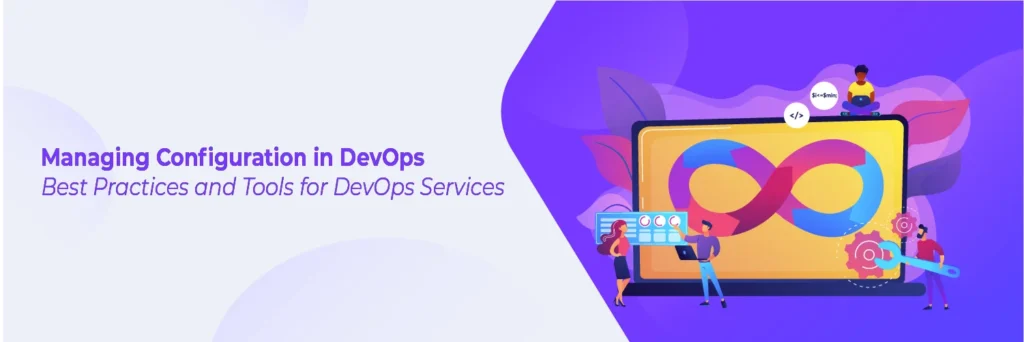Configuration management, as the name implies, is nothing more than managing all of the configurations of the environments in which the software application operates.
As we all know, many environments exist in DevOps throughout the SDLC, beginning with unit testing and progressing to integration testing, system testing, acceptance testing, and end-user testing.
So, in a nutshell, configuration management is the automated process of managing all of these environments’ configurations. Many organizations have adopted DevOps as an approach to streamline their software development and deployment operations. DevOps consulting services and DevOps services and solutions have grown in popularity in recent years, and they provide numerous advantages to organizations who are wishing to improve their software development practices. Configuration management, which involves controlling the configuration of software programs throughout their lifecycle, is an important part of DevOps. Their lifecycle is an important part of DevOps. FUTURISTECH is one of the examples of will explore the best practices and technologies for managing configuration in DevOps services in this article. Are you looking for DevOps services in Australia? Look no further as our company is here to offer your business top-notch services.
Best Practices for Managing Configuration in DevOps
- Use Automation: Automation is a key element of DevOps and is required for configuration management. Automation can help to decrease the time and effort necessary to maintain configuration, as well as errors and consistency. To manage configuration, automation technologies such as Chef, Puppet, and Ansible are often used in DevOps.
- Version Control: Another key element in DevOps configuration management is version control. Version management tools such as Git can assist in tracking changes to configuration files and ensuring that changes are made in a controlled and auditable way. Version control may also be helpful in the interaction of development and operations teams.
- Use a Configuration Management Database (CMDB): A CMDB is a database that stores information about software application settings. A CMDB can serve to give a centralized view of an application’s configuration, as well as ensure that modifications are done in a controlled and auditable manner.
- Use Configuration as Code: Configuration as Code is a practice in which configuration files are written in a programming language. This technique is useful in ensuring that setup is consistent and repeatable, as well as in facilitating collaboration between developers and operations teams.
- Test Configuration Changes: Testing is an important element of DevOps configuration management. Configuration modifications should be properly verified to ensure that they have no unintended implications. Configuration changes can be tested using automated testing tools such as Selenium and JMeter.
Tools for Managing Configuration in DevOps
- Chef: Chef is a configuration management tool for managing software application settings. Chef describes an application’s configuration using a declarative language, and it may be used to automate application deployment.
- CFEngine:Teams can manage system security, access control, user management, patch management, and provisioning of physical and virtual infrastructure with CFEngine from one dashboard.. Autonomous agents in CFEngine are constantly monitoring, repairing, updating, and restoring an IT system. In CFEngine, continuous system inspections and automatic remediation ensure dependability and consistency across an infrastructure.
- Puppet: Puppet is another open-source software appropriate for provisioning resilient infrastructure. DevOps experts can use Puppet to configure, install, and run servers, as well as automate application deployment on the configured servers. Puppet is a configuration management solution for managing software application settings. Puppet describes an application’s configuration using a declarative language and can be used to automate it.
- Ansible: It is a Python-based open source command-line IT automation software programme. It has the ability to deploy software, configure systems, and orchestrate intricate workflows to support the deployment of applications, system updates, and other tasks. The key advantages of Ansible are its simplicity and ease of use.
- Terraform:An open-source SCM platform for easily managing clusters, services, and parts of cloud-based infrastructure via IaC. The platform is simple to integrate with Azure, AWS, and a variety of other cloud providers. Databases, servers, and other vital components all have their own interfaces and representation methods. You can configure repeatable cloud infrastructure deployments, with the platform assisting you in provisioning AWS resources from text files and autonomously handling the set deployment activities.
- Salt: Salt was designed to collect data quickly and scale to tens of thousands of servers. Python modules are used to handle configuration information and particular operations. These modules are in charge of Salt’s remote execution and state management. Configuring the modules necessitates some technical knowledge. Salt employs a client-server architecture (with the Salt master serving as the server and the Salt minions serving as clients). Salt state files include all of the information needed to keep a system in the appropriate state.
- RackHD: RackHD is a platform for automated hardware management and orchestration that uses coherent APIs. Developers can take advantage of the APIs supplied by RackHD to construct an interface for users to use as a single point of access to manage all hardware services. It has a large community channel. It allows you to automate a wide range of management operations, including Installation, bug creation, and feature requests.
- Vagrant: Vagrant is an outstanding solution for setting up and managing virtual machines in a single workflow for development with the simplest processes possible. Vagrant is a cross-platform virtualization solution that works on top of VM solutions such as VMware, VirtualBox, and Hyper-V. The vagrant file contains all of the configurations required to create a VM (virtual machine). It minimizes the time required to set up a development environment, increasing productivity.
- JUJU: JUJU is an open-source configuration management application. It enables you to efficiently configure, deploy, operate, and manage cloud applications on public cloud platforms as well as OpenStack, physical servers, and containers. JUJU can be accessed via the GUI or the command line.
- Cobbler: Cobbler is a well-classified Linux provisioning server that automates the network-based system installation of different computer operating systems. Cobbler facilitates and automates system installations and initiates and controls installations via network boot. In addition, it enables repository mirroring, kick-start templates, and maintains connectivity with available power management systems. There are several features that make it even more powerful, such as configuration management, XML RPC APIs, and the KOAN client.
Conclusion
The best way to identify the right tools for your needs is to explore them. Try them out to see how they perform and how they might help your organization maintain a secure and consistent setup since what works for others may not work for you.


